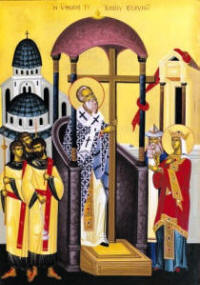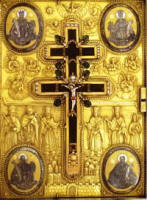
On this day are commemorated two events connected with the Precious Cross of Christ: the first, the finding of the Cross on Golgotha and the second the returning of the Cross to Jerusalem from Persia.
Staying in the Holy Land, the holy Empress Helena decided to look for the Precious Cross of the Lord. An old Jew called Judah was the only person who knew the whereabouts of the Cross, and, under pressure from the Empress, he revealed that the Cross was buried under the Temple of Venus that the Emperor Hadrian had built on Golgotha. The Empress ordered that this idolatrous temple be pulled down, and then, digging deep below it, she found three crosses.
| While the Empress was in uncertainty about how to recognize which cross was the Lord’s, a funeral procession passed by. Then Patriarch Macarios told them to place the crosses one by one on the dead man. When they placed the first and second on him, the dead man remained unchanged, but when they placed the third on him, he was restored to life. By this, they knew that this was the Precious and Life-giving Cross of Christ. After that, they placed it on a sick woman, and she recovered. Then the Patriarch raised the Cross aloft for all to see, and the people sang with tears: “Lord, have mercy!” The Empress Helena had a silver casing made, and placed the precious Cross in it. |
|
Patriarch Zacharias saw an angel directing the Emperor to take off his imperial robes and walk beneath the Cross along the way that Christ had walked, barefoot and humiliated as He had been. He passed this vision on to the Emperor, who stripped himself of his raiment and, in poor clothing and barefoot, took up the Cross, carried it to Golgotha and placed it in the Church of the Resurrection, to the joy and consolation of the whole Christian world. -The Prologue from Ochrid of Bishop Nicholai (Velimirovich) |
The Cross is our pride,
by which we accept the death of the Master as the way to Resurrection
for deliverance from all sin. The baptism which we undertook was
described by Paul as the participation with the Lord in His burial and
in the Resurrection: “Knowing this, that our old
 man
was crucified with Him, that the body of sin might be done away with,
that we should no longer be slaves of sin.” (Rom 6:6) This is the center
of our faith. This is our vitality.
If we post the Cross on
the top of the Iconostasis, we do so in order that the meaning of the
New Life shall stand before us and elevate us to Jesus in heaven, that
we may forget all earthly care. And if we make the sign of the Cross
over the baptismal water, we do it in order that the power of Salvation
may descend upon the baptized through the water he is being washed with.
In our Church, every symbol has its own meaning. When we Cross
ourselves, we ask the Lord to send down upon us the power of Salvation
as pictured in this symbol.
man
was crucified with Him, that the body of sin might be done away with,
that we should no longer be slaves of sin.” (Rom 6:6) This is the center
of our faith. This is our vitality.
If we post the Cross on
the top of the Iconostasis, we do so in order that the meaning of the
New Life shall stand before us and elevate us to Jesus in heaven, that
we may forget all earthly care. And if we make the sign of the Cross
over the baptismal water, we do it in order that the power of Salvation
may descend upon the baptized through the water he is being washed with.
In our Church, every symbol has its own meaning. When we Cross
ourselves, we ask the Lord to send down upon us the power of Salvation
as pictured in this symbol.
Likewise, if we wear a
Cross around our neck since baptism, we confirm our![]() Christian faith and that we are attached to Jesus. Some may wear a
golden Cross, which at times becomes fashionable. This could have a much
deeper meaning if the wearer held fast to chastity. Let us move from
visible decorations to internal decoration and have the Cross carved in
our hearts too.
Christian faith and that we are attached to Jesus. Some may wear a
golden Cross, which at times becomes fashionable. This could have a much
deeper meaning if the wearer held fast to chastity. Let us move from
visible decorations to internal decoration and have the Cross carved in
our hearts too.
When we Cross ourselves over the face, chest and shoulders, let us feel the connection with the Crucified. We do this every time the name of the Trinity is mentioned or glorified in prayers because the Trinity decided to allow the death of the Son in our days from all eternity. The true Glory descends upon us through the death of the Savior and through our faith in Him.
This is our pride and power. This is what the martyrs have delivered to us.-written by Metropolitan George (Khodr) of the Antiochian Archdiocese of Mount Lebanon
Copyright 2019.St. George UGCC. All Rights Reserved.